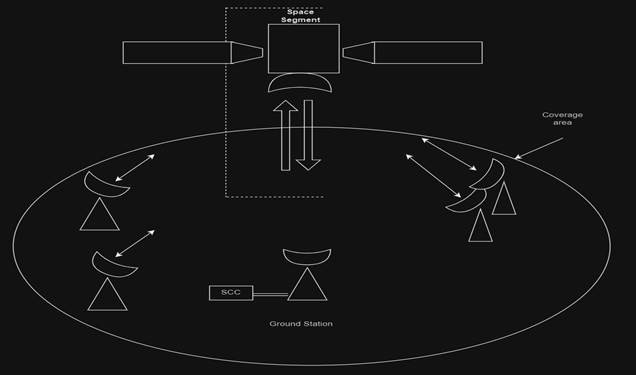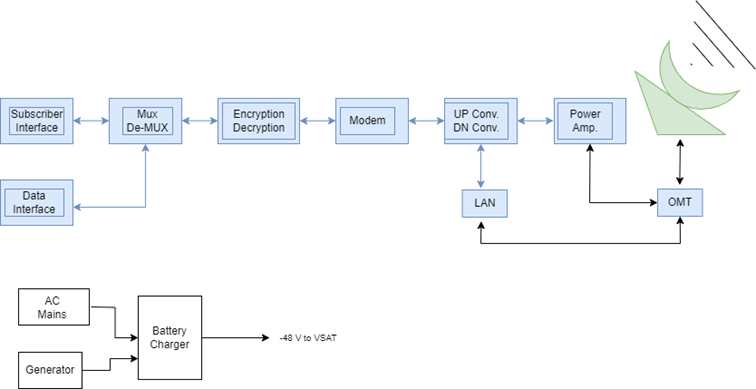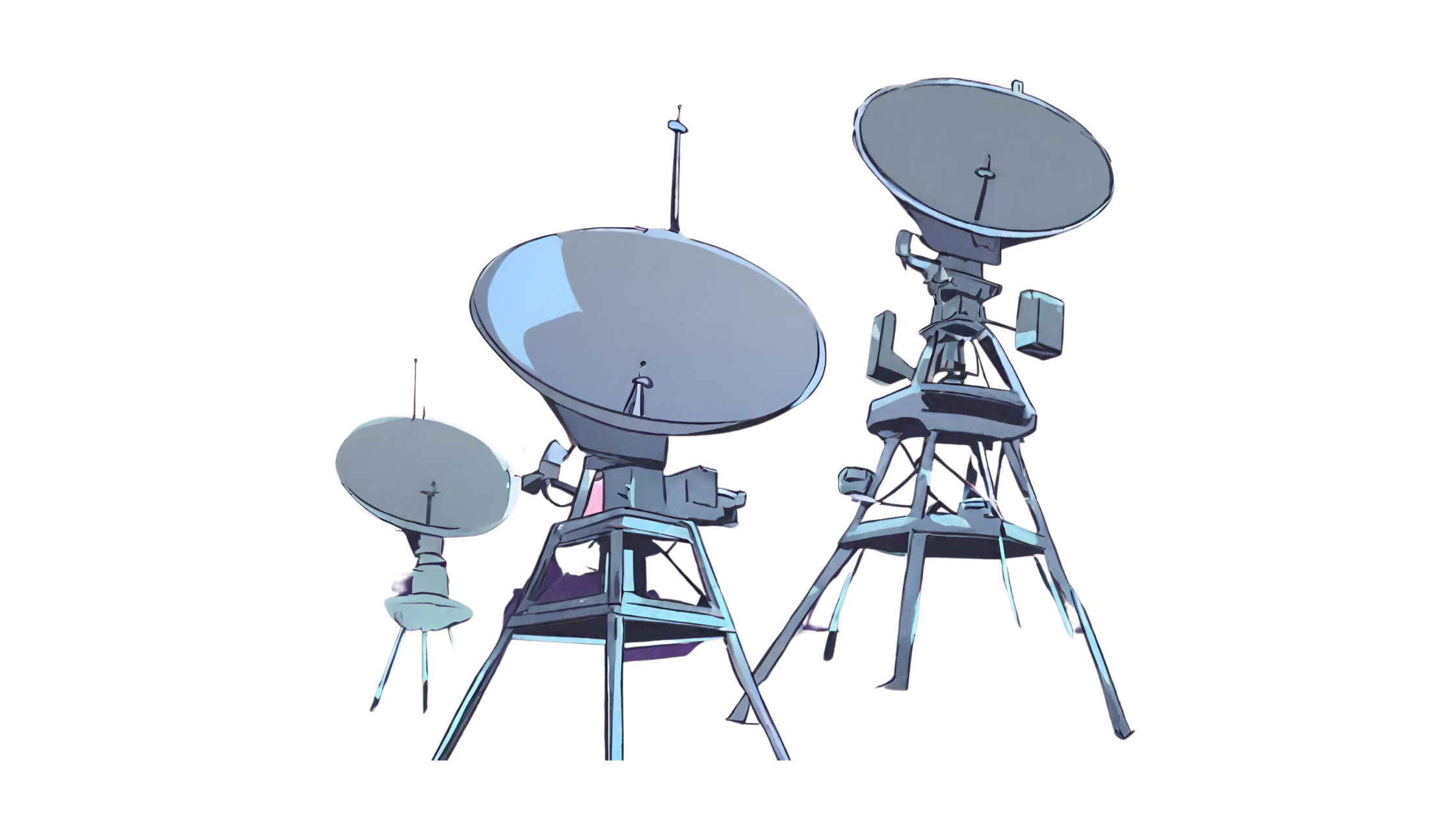In the vast expanse of the digital age, communication has transcended beyond physical boundaries, connecting remote areas to the pulsating heart of global interaction. Very Small Aperture Terminal (VSAT) systems have emerged as a pivotal technology, bridging the gap between isolated locations and the bustling digital world. This blog unfolds the intricate tapestry of VSAT systems, exploring their foundational basics and their indispensable role in contemporary communication.

VSAT, an acronym for Very Small Aperture Terminal, refers to a type of satellite communication system primarily utilized for transmitting data, voice, and video signals. The system encompasses three main components: a satellite, a central hub (also known as a Network Operations Center or NOC), and the VSAT terminals. The VSAT terminals, with their compact antenna sizes ranging from 0.75 to 2.4 meters in diameter, facilitate communication between the NOC and the user, utilizing the satellite as a relay point.
VSAT Frequency Bands: Bridging Diverse Communication Needs
VSAT systems operate across various frequency bands, each offering unique characteristics suitable for different communication needs and applications. The commonly used bands include:
- L-Band (1-2 GHz): Predominantly used for mobile satellite communication.
- S-Band (2-4 GHz): Ideal for weather radar systems and some communication satellites.
- C-Band (4-8 GHz): Widely utilized for long-distance telecommunication.
- X-Band (8-12.5 GHz): Often reserved for military and government communication.
- Ku-Band (12.5-18 GHz): Popular for direct-to-home broadcasting due to its resistance to weather interference.
- K-Band (18-26.5 GHz): Employed for high-capacity satellite links.
- Ka-Band (26.5-40 GHz): Known for its high-speed internet capabilities.
Each band offers a unique blend of capabilities, ensuring that diverse communication requirements, from weather forecasting to high-speed internet provision, are met with precision and reliability.
VSAT Network Architecture: The Framework of Connectivity
The architecture of a VSAT network is predominantly categorized into two types: Star and Mesh topology.
- Star Topology: In this configuration, all VSAT terminals communicate through the central hub. The hub manages the network control and sometimes even the content, ensuring streamlined communication between all terminals.
- Mesh Topology: This allows direct communication between VSAT terminals without the need to relay data through the hub, fostering efficient peer-to-peer interactions.
The choice between star and mesh topology hinges on the specific communication needs, budget, and desired level of control over the network.
VSAT Applications: A Spectrum of Possibilities
VSAT systems have permeated various sectors, offering a myriad of applications that bolster connectivity and enhance operational efficiency.
- Remote Education: VSAT facilitates e-learning in remote areas, ensuring that quality education is accessible even in the most isolated locations.
- Telemedicine: Medical consultations, diagnostics, and treatment advice can be transmitted to remote health centers, ensuring healthcare reaches every corner of the globe.
- Retail: Retail chains utilize VSAT for transaction processing, inventory management, and ensuring consistent communication across all outlets.
- Disaster Management: In the aftermath of natural disasters, VSAT systems provide critical communication channels, coordinating rescue efforts and ensuring aid reaches those in need.
Understanding VSAT: The Basics
VSAT, an abbreviation for Very Small Aperture Terminal, refers to a type of earth station that establishes a communication link via satellite using Radio Frequency (RF) links. These terminals typically feature antennas of varying diameters and serve as crucial communication links for establishing a satellite-based communication network. VSATs are versatile, capable of transmitting and receiving voice, data, and video signals.
Key Components of a VSAT System
- VSAT Outdoor Unit (ODU):
The ODU is typically positioned near the antenna systems outdoors, hence its name. It encompasses several critical components:
- Antenna System: Houses the reflector, feed horn, mount, and cables. The antenna sizes usually range from 1.8 to 3.8 meters in diameter.
- RF Transceiver: Comprising Up/Down converters that convert frequencies from Intermediate Frequency (IF) to RF frequencies and vice versa.
- Power Amplifier: Amplifies the signal before it is transmitted to the feed horn of the Antenna system.
- Low Noise Amplifier (LNA): Amplifies the received signal from the satellite, designed to amplify the signal without amplifying the noise.

- VSAT Indoor Unit (IDU):
The IDU, located inside a building, comprises:
- MUX/DEMUX: Interfaces with end-user equipment like computers, telephones, or sometimes with EPABX and LAN or router, multiplexing channels using Time Division Multiplexing (TDM).
- Encryption Decryption Unit (EDU): Provides security by modifying the information to be transmitted and decrypting received information.
- Modem: Performs modulation and demodulation functionalities, inserting information on an intermediate frequency (IF) and employing Forward Error Correction to enhance the Bit Error Rate (BER).
VSAT Installation Procedure:
VSAT installation is a meticulous process that involves several steps:
Step 1: Unpack all subsystems, including Antenna and accessories, Feed Horn, OMT, BUC, LNB, Satellite Modem, MUX, and EDU.
Step 2: Mount the Antenna along with support, ensuring not to tighten all the screws initially.
Step 3: Determine the satellite latitude and longitude for VSAT tuning. Calculate the required Azimuth and Elevation for antenna alignment using calculators or manual calculations.
Step 4: Align the antenna using the calculated Azimuth and Elevation angles, ensuring accurate pointing towards the Geo satellite.
Step 5: Connect the ODU and IDU using a coaxial cable, ensuring the length is approximately 300 foot (around 90 meters).
Step 6: Perform a Cross Pol test and fine-tune the antenna for optimal signal quality.
Step 7: Complete the installation by securing all connections and conducting a final system check.
VSAT: A Vital Communication Link
VSAT systems have become indispensable in establishing communication networks, especially in remote areas where terrestrial connectivity is limited. They provide a reliable communication link, ensuring data, voice, and video transmission even in the most isolated locations.
VSATs are integral in various sectors, including telemedicine, remote education, banking, and more, ensuring connectivity and communication are uninterrupted and reliable. The meticulous design of VSAT systems, from the strategic setup of the outdoor and indoor units to the precise installation process, ensures that communication remains steadfast, bridging gaps and connecting the world in the vast expanse of the digital age.
Challenges and Solutions in VSAT Deployment
Despite its myriad of applications, deploying VSAT systems is not without challenges. Issues such as signal interference, installation costs, and regulatory hurdles often surface. However, with advancements in technology, solutions like adaptive coding and modulation, high-throughput satellites, and the development of cost-effective terminals have significantly mitigated these challenges.
To conclude, in a world where communication is paramount, VSAT systems stand out as a robust and reliable solution, ensuring that no matter where you are, you stay connected. From the intricate components that make up the indoor and outdoor units to the precise installation procedures, VSAT technology exemplifies the marvel of human ingenuity in the realm of communication technology.
Incorporating VSAT into various sectors has not only enhanced operational efficiency but also ensured that geographical barriers are no longer a hindrance to seamless communication. As we continue to explore and innovate in the realm of satellite communication, VSAT systems will undoubtedly play a pivotal role in shaping the future of global connectivity.




